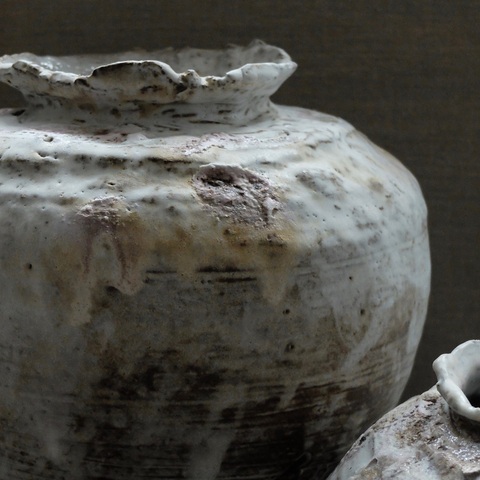Surface Detailing in Handmade Ceramics
One of the things that makes our handmade ceramics collection at Maud and Mabel so eclectic is the variety of surface detailing. With particular methods and techniques, ceramicists create surface detailing that makes their work irrefutably their own.
Ashraf Hanna
The collection of works created especially for Maud and Mabel by Ashraf Hanna are an extraordinary range of forms from his cut and altered series. Ashraf is concerned with the placement of his ceramic vessels and their interaction with each other. The relationship between the pieces, which are disparate in size and shape, is ensured by their uniformity of texture. This rough surface is achieved through multiple firings.
When the clay is leather hard, the work is biscuit fired. After this, the final surface treatment is applied. The application, through spraying, of a layer of ultra-refined coloured clay slips (terrra sigillata), and subsequent firing is repeated a number of times.
What is Terra Sigillata?
Terrra sigillata is clay slip that has been used since the Ancient Greek period. Greeks and Romans used terrra sigillata as a glaze (before they existed) as the ultra-refinement of the clay-slip result in glosses and sheens, depending on the dryness of the surface that it is applied to. Ashraf’s use of this method results in the accentuation of the exceptionally unique surface texture.
Like terrra sigillata, the burnishing of clay is a historic version of glazing and was used by potters to make their ceramics watertight. Contemporary ceramicists still burnish clay because of the surface texture it creates. Burnished ceramics are not covered in a coating like glazed ceramics are, there is nothing separating your hand and the clay, making vessels warm and enticing to the touch. Clay can be burnished in two ways; with a smooth object such as a polished stone or a soft material like chamois leather.
Enriqueta Cepeda
Enriqueta Cepeda’s interest in the ceramic practices of different ancient cultures informs her method of burnishing vessels. Enriqueta uses a stone to burnish the surface before they are fired, a time-consuming method which requires a lot of practice to perfect. After firing, she polishes the pieces with organic beeswax. She also scrapes the surfaces of her work, revealing the grogg, creating contrasting elements of rough and smooth.
Ann Van Hoey
Ann Van Hoey’s work has sides that are inspiring in their paper-thin delicacy. Ann’s handmade stoneware pieces are made using hand-held tools. The surface detailing varies, from polished to as smooth as eggshell, to dimpled patterning in ways that echo their geometric forms. Her exploration of the importance of surface detailing in ceramics and their resulting message is demonstrated in ‘The Earthenware Ferrari’, for which she received silver in the Cheongju Craft Biennale in Korea in 2013. ‘The Earthenware Ferrari’ series take the geometric forms for which Ann is celebrated, but as opposed to the more neutral colours she favoured at the beginning of her career, the ceramics are coated in Ferrari red and other colours inspired by motoring brands, cleverly combining the ancient use and manipulation of clay with a symbol of contemporary consumer society to comment on tradition and modernity.
Abigail Schama
The beauty of Abigail Schama’s works lie in the surface detailing processes that she uses. The humanity of her vessels and their ability to tell stories makes sense with the knowledge that her techniques include ‘slipping’ and ‘chattering’, words which describe human contact. Whilst slipping is the application of a series of layers of slips, for chattering, a pottery trimming tool is used on clay that is quite dry to create random and spontaneous decoration.
Masako Nakagami
The technique of fluting can be seen in the work of Japanese ceramicists like Masako Nakagami. The term fluting is derived from architecture and is done when the clay is leather-hard with a loop tool. In Masako’s fluted works, the grooves intensify the tactile nature that their scale invites and highlights their soft and curved forms. As a ceramicist influenced by the natural world, Masako’s preference for these fluid lines recalls rivers and streams.
Explore our collection of ceramics in our gallery, or on our website, and take note of the exceptional surface detailing that so many of our pieces feature.





